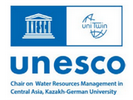



Year: 2025
Collections: Scientific Publications
Topics: Water, Climate
Authors: Thevs Niels, Aliev Kumar, Baier Clara
Countries: Kyrgyzstan
Source: water-ca.org
Recently, Paulownia spec. has been introduced to Central Asia in a number of small plantations. Paulownia yields timber of high quality for applications such as furniture, house construction, boat construction, and surf boards, or skis. Thus, Paulownia might offer a much-needed raw material for this region and beyond. However, Central Asia is largely occupied by drylands so that Paulownia needs irrigation. Against the background of frequent water stress across the region, this study aimed at assessing the water consumption and water productivity of that tree, using a 6-year-old plantation as study site. Trees were planted in May 2017 and cut back to their stumps in 2018. Daily crop evapotranspiration was calculated after the Penman-Monteith approach, whereby the crop coefficients were inherited from actual evapotranspiration values which stemmed from the remote sensing approach S-SEBI. Water consumption per tree was 1741 l, 4461 l, 4500 l, and 4407 l over the growing seasons 2020, 2021, 2022, and 2023, respectively. The water productivity for the stem wood over the whole time-span from planting in 2017 until 2023 was 1.59 g l-1 and 5.65 ml l-1. Given the high quality of its timber and its range of high-value applications, it can be concluded that the water consumed by Paulownia enables higher value timber and timber products than other trees that grow in comparable areas of Central Asia.
Year: 2025
Collections: Scientific Publications
Topics: Water, IWRM
Authors: Gafurov A., Ziganshina Dinara, Assubayeva A., Nodir Djanibekov, Abdullaev Iskandar, Bobojonov Ihtiyor, Dombrowsky Ines, Hamidov Ahmad, Herrfahrdt-Pähle Elke, Janusz-Pawletta Barbara, Ishangulyyev Rovshen, Kasymov Ulan, Mirkasimov Bakhrom, Petrick Martin, Strobehn Katrin
Countries: Kazakhstan, Kyrgyzstan, Uzbekistan, Tajikistan, Turkmenistan
Source: water-ca.org
Political tensions over water management in the Central Asia region have intensified since the Soviet era, as ecological issues like the drying Aral Sea and seasonal hydropower disruptions impact downstream countries. The paper discusses the region’s water governance challenges, including climate-induced uncertainties, water resource demands, and the limited capacity of local research institutions. While Central Asia’s governments have initiated reforms, including new infrastructure and agreements, resilience in water management remains underdeveloped. The paper also explores the role of higher education institutions in fostering capacity-building for sustainable governance, emphasizing the need for local expertise and regional collaboration. The proposed establishment of a Central Asian water research platform aims to enhance science-policy integration, promote sustainable water governance, and support informed regional cooperation on transboundary water issues.
Year: 2025
Collections: Scientific Publications
Topics: Agriculture
Authors: Ankit Garg, Sai Krishna Akash Ramineni, Neelima Satyam, Askar Zhussupbekov
Countries: Kazakhstan, Kyrgyzstan, Uzbekistan, Tajikistan, Turkmenistan
Source: https://cajscr.com/
Soil salinity in Central Asia negatively impacts soil structure, leading to degradation and reduced water infiltration. This not only hampers agricultural productivity but also makes the land less suitable for construction due to its high susceptibility to deformation. Environmentally friendly materials like biochar, a carbon-rich substance, show promise in reducing the deformation of saline soils. However, the mechanisms behind its effectiveness are not yet fully understood. This study aims to analyse saline clays’ dispersion and sedimentation behaviour under varying pore water salinity levels (0 % to 10%). A biochar content of 5 % was selected as it is found to be optimum for plant growth and erosion resistance. It was found from the study that the biochar increases the aggregation of soil particles and enhances flocculation, improving soil dispersion characteristics. Biochar facilitates soil particle aggregation by increasing the cation exchange capacity. At higher pore water salinity levels (5% and 10%), the sedimentation behaviour of biochar-treated soil particles deviates from expectations, showing slower sedimentation rates and lower sedimentation heights. This is because the sodium ions are adsorbed by biochar, reducing salt’s effect on dispersion and sedimentation. The results demonstrate that biochar effectively enhances the stability of saline soils and, hence, has a potential use for ground improvement in the Central Asian region.
Year: 2025
Collections: Manuals
Topics: Water, IWRM
Authors: Kogutenko Larissa, Safiya Asalbekova, Michael Walther
Countries: Kazakhstan, Kyrgyzstan, Uzbekistan, Tajikistan, Turkmenistan
Source: Journal of MOLARE Research Centre (MRC)
Why water monitoring and assessment are important?
Water quality assessment is one of the crucial scientific and practical analyses to identify the possibility of water consumption for different human needs and nature/ecosystem conservation for future generations. Water quality can be measured and monitored in rivers, springs, creeks, swamps, estuaries, wetlands and lakes what is called aquatic systems. Quality parameters, such as biological, chemical and physical indicators identify the combination of values that influence the composition of water. Monitoring and comparison of different water habitats (macro invertebrates) in biological monitoring provides an information of water quality and allows to make a quick assessment.
For questions about cooperation, please contact us at: